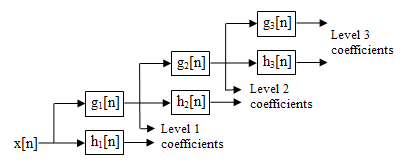Stationary wavelet transform
The stationary wavelet transform (SWT) is a wavelet transform algorithm that aims to eliminate the shift variance of the discrete wavelet transform (DWT). In the case of minimally shifted signals, this leads to considerably different wavelet coefficients and not to minimally shifted but otherwise identical coefficients.
The stationary wavelet transformation is an alternative to the continuous wavelet transformation in signal analysis with regard to the time or location axis, but it is discrete-scale. For example, it is used for edge detection.
Shift invariance is achieved by removing up- and downsampling steps of the DWT and adding upsampling of the filter coefficients with a factor of on the tenth scale of the algorithm. The SWT is an inherently redundant scheme in that the output on each scale of the SWT contains the same number of samples as the input. In this way, a -fold redundancy of the wavelet coefficients arises when decomposing to scales .
The algorithm is also known as " algorithme à trous " in French ( trous : holes), which refers to the zeros inserted in the filter coefficients. It was developed by Holschneider et al. introduced.
implementation
The following block diagram shows a digital implementation of the SWT.
In the diagram above, the filters of the previous scale, for which the sampling rate was increased ( upsampling ), are used for each scale (see figure below).
application areas
The SWT is used in various areas, e.g. B. in
Synonyms
The idea of leaving out the undersampling of the discrete wavelet transform is sufficiently intuitive that this variant was "invented" several times, each with different names.
- stationary wavelet transform ( stationary wavelet transform )
- redundant wavelet transform ( redundant wavelet transform )
- Algorithms à trous
- quasi-continuous wavelet transform ( quasi-continuous wavelet transform )
- shift-wavelet transform ( shift-invariant wavelet transform )
- invariable wavelet transformation ( translation-invariant wavelet transform )
- Wavelet transformation with maximum overlap ( maximum overlap wavelet transform , MODWT)
- Undecimated wavelet transform (UWT)
- Cycle spinning
Individual evidence
- ↑ James E. Fowler: The Redundant Discrete Wavelet Transform and Additive Noise , contains an overview of the various names for this transformation.
- ^ W. Bäni: Wavelets: An Introduction for Engineers. Oldenbourg Wissenschaftsverlag 2005
- ↑ Mark J. Shensa, The Discrete Wavelet Transform: Wedding the A Trous and Mallat Algorithms, IEEE Transaction on Signal Processing, Vol 40, No 10, Oct. 1992.
- ↑ M. Holschneider, R. Kronland-Martinet, J. Morlet and P. Tchamitchian. A real-time algorithm for signal analysis with the help of the wavelet transform. In Wavelets, Time-Frequency Methods and Phase Space , pp. 286-297. Springer-Verlag, 1989.




